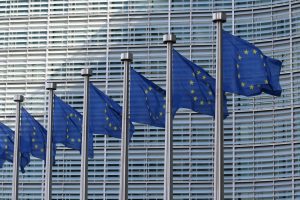
This is the 3rd article of our ‘EU to improve Public Transport’ articles. Our first two articles discuss technical development and connectivity of the railway system.
Mobility has increased immensely over the past few decades. Ask any person around you how much of the world they have seen, and you will get completely different answers compared to twenty years ago. The world has become smaller and increasingly connected, allowing us to travel more, yet also have a larger footprint as we go around. Our means of mobility have evolved parallel to our new norms of traveling. Yet, how come that with the increase of travel, public transport has gained slower adoption compared to car usage?
The proportion of train and bus usage compared to total transportation has seen a decline of 1,2% over the past twenty years. Although this doesn’t necessarily imply a decrease in the use of public transport overall, it does tell us that the use of other modes has gained larger traction throughout time. And this poses a problem if we want to keep being mobile, without harming our planet.
In order to tackle this, last December, the European Commission adopted four different proposals to modernise and improve the EU’s transportation system. These proposals focus on aspects such as high-speed railway connections, increase in transhipment terminals, and sustainable urban mobility. So what are the proposed actions the European Commission will take, and what else is needed to change mobility behaviour towards a more sustainable norm? Here are some of our thoughts on four key pillars for development of the public transportation system: technological capabilities, economic policy, connectivity, and digital innovation.
Booking your flight for a cup of coffee
In our last articles we discussed technical development and connectivity as factors to improve public transport adoption. Yet still, technical capabilities and improved connectivity alone won’t suffice as we all realize. Adoption rates of (international) train commuting are hampered by the large differences in affordability compared to other modes.
Why is it that a flight from London to Milan can drop to prices of five pounds, whereas a last-minute train ticket can add up to a few hundred? This means that you could travel 1280 kilometers, for the price of a cup of coffee. Yes, you read that right… a cup of coffee! With our current awareness of the climate crisis, we cannot afford such things from happening anymore.

Because even with airlines coming up with new ways to incentivize travellers to add green options to their journeys (think of CO2 compensation schemes, planting trees, etc.), there is only so much that really can be compensated for. Often we’re more looking at greenwashing practices than actual green options. So instead of adding things to make up for unsustainable travel, why not consider the green transport options we already have, and choose to improve them?
Luckily, during the last COP in Glasgow, countries realised that this may be the most successful way to achieve our goals. Acceleration of climate action is needed, and therefore the commission revised their plans for public transport development again. We have been touching upon several aspects of these plans, but not yet on the financial side of things.
General strategies to level the playing field
The example of prices for a flight versus train from London to Milan perfectly illustrates the disbalance in our market. Governmental intervention is needed to make sustainable travel more competitive and this is not simply adding supply to the market in the form of more trains and better connections.
How appealing those cheap airlines may be, measures such as CO2 taxes for European flights would probably be the first place to start. Fairer prices for the impact of flying to your favourite destination asks people to think twice before booking a quick trip across Europe. An increase in flight prices would probably cause an instant move of the market equilibrium, meaning less demand followed by less supply in the long run.
Subsidies or VAT exemptions for train tickets can provide a larger boost to increase adoption rates. As part of their proposal, the European Commission has stated wanting to investigate such a policy by exploring an EU-wide VAT exemption for train tickets. This could really level the playing field for train transportation compared to flying, especially when journeys are smoothly connected so that quality and price both appeal to the consumer.
Supporting specific target-groups
What else is important, which is currently being explored by the Commission, is a way to adjust the reimbursement rules for Erasmus students so that sustainable transportation is encouraged. Today’s students are very used to including international travel to their academic experience. In 2018, 1.3 million students in the EU came from abroad and every year over 300,000 students take part in an Erasmus exchange program, where they spend one semester at a university in a different EU country.
Although this is an exciting opportunity for both students and universities, it often goes paired with many flights back and forth during those periods. Many of which could be replaced by long-distance train journeys, if only financial support would be provided. Therefore, it is important for the Commision to not only alter rules making it more expensive for students to fly, but also provide enough financial support to enable students to catch the train.

And what can be done for students can also be explored for other societal groups. By focussing on the barriers and support needs of specific consumer segments, the EU could make transportation more affordable for all. There are always opportunities to exploit. Think of the pandemic and getting your vaccinations. To get people to their vaccination centre, the government could promote bus or train tickets, or even a shared bike through interesting campaigns. Or consider leisure activities for vulnerable groups in society which could receive extra budget when sustainable transport modes are opted for. There are many ways for governments to tailor support of green transportation to specific target groups and contexts.
Combining strategies to accelerate climate action
So, on top of improved connectivity and infrastructure throughout Europe, we believe that financial policy and support is vital for the adoption of train transportation. Some of these policy measures are more general ones, such as the potential realisation of a EU-wide VAT exemption on train tickets. Other tools and guidelines could be much more tailored specifically to different target groups, of which the Erasmus program is a clear example. Combining both general and specific strategies could remove the financial barriers for different societal groups, allowing for an increase in the adoption of train travel in the very near future.
We have one last article coming up, where we discuss the role of digital innovation within the public transit system. Together with the topics we have covered so far, we see digital innovation largely influencing the consumer in their mobility choices. Stay tuned!

